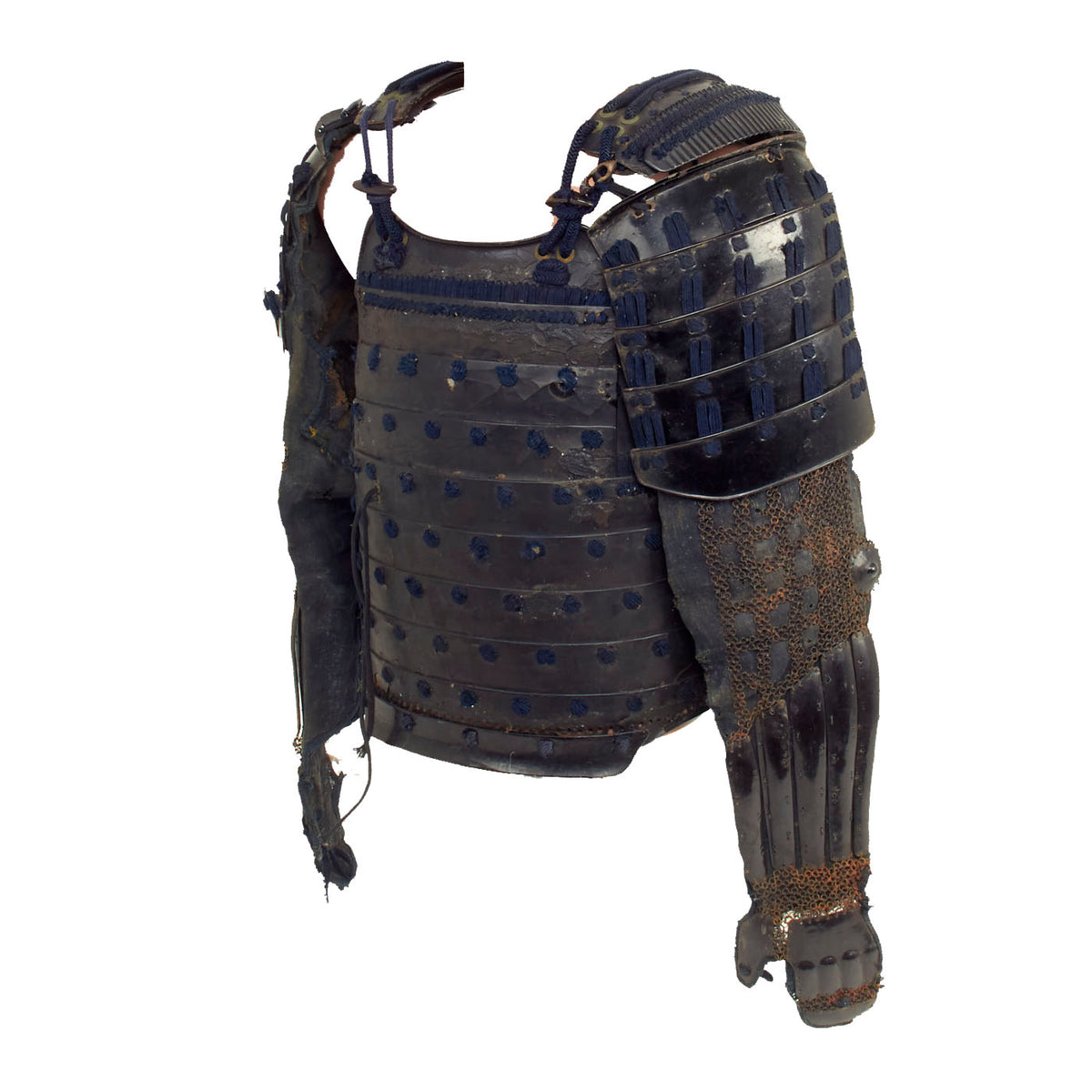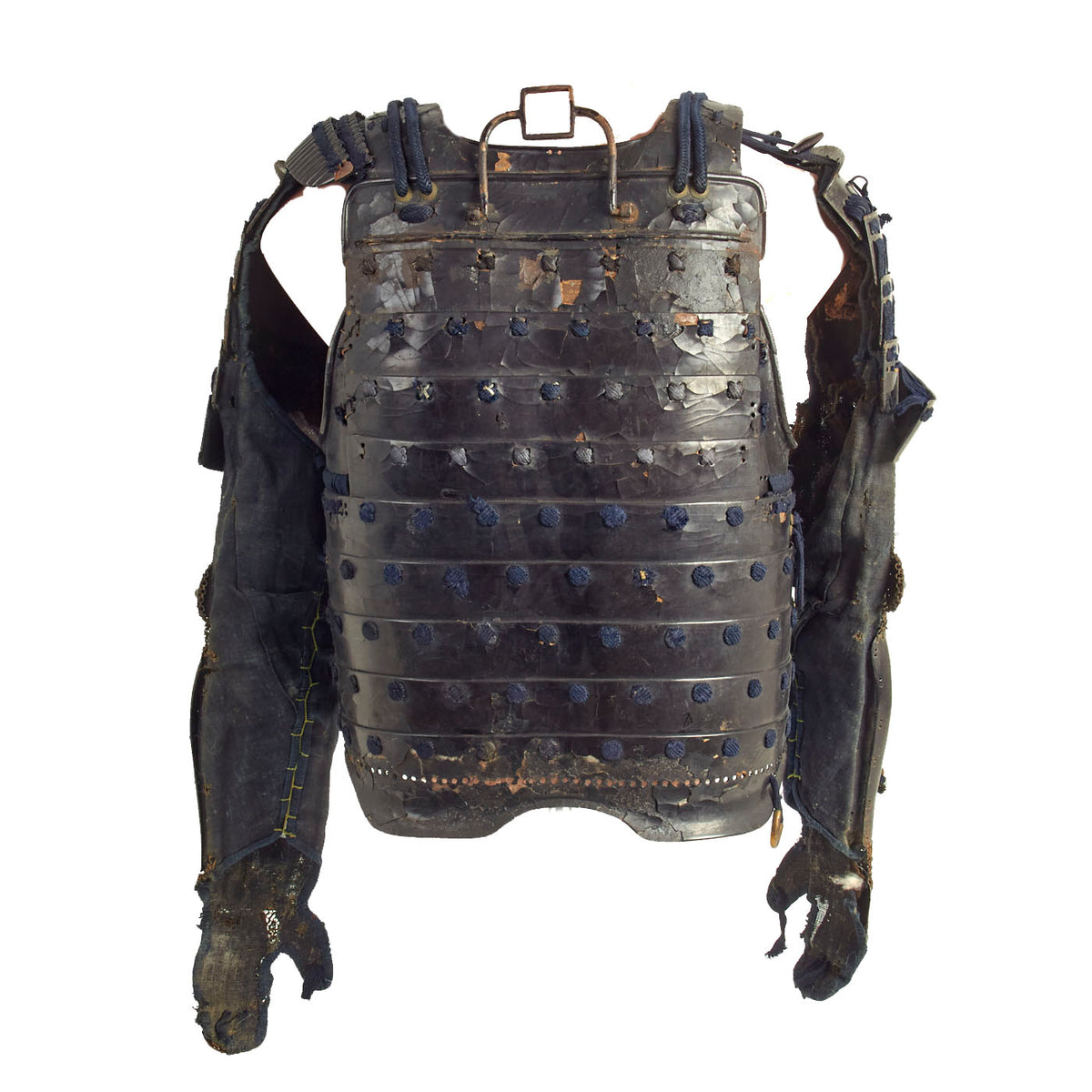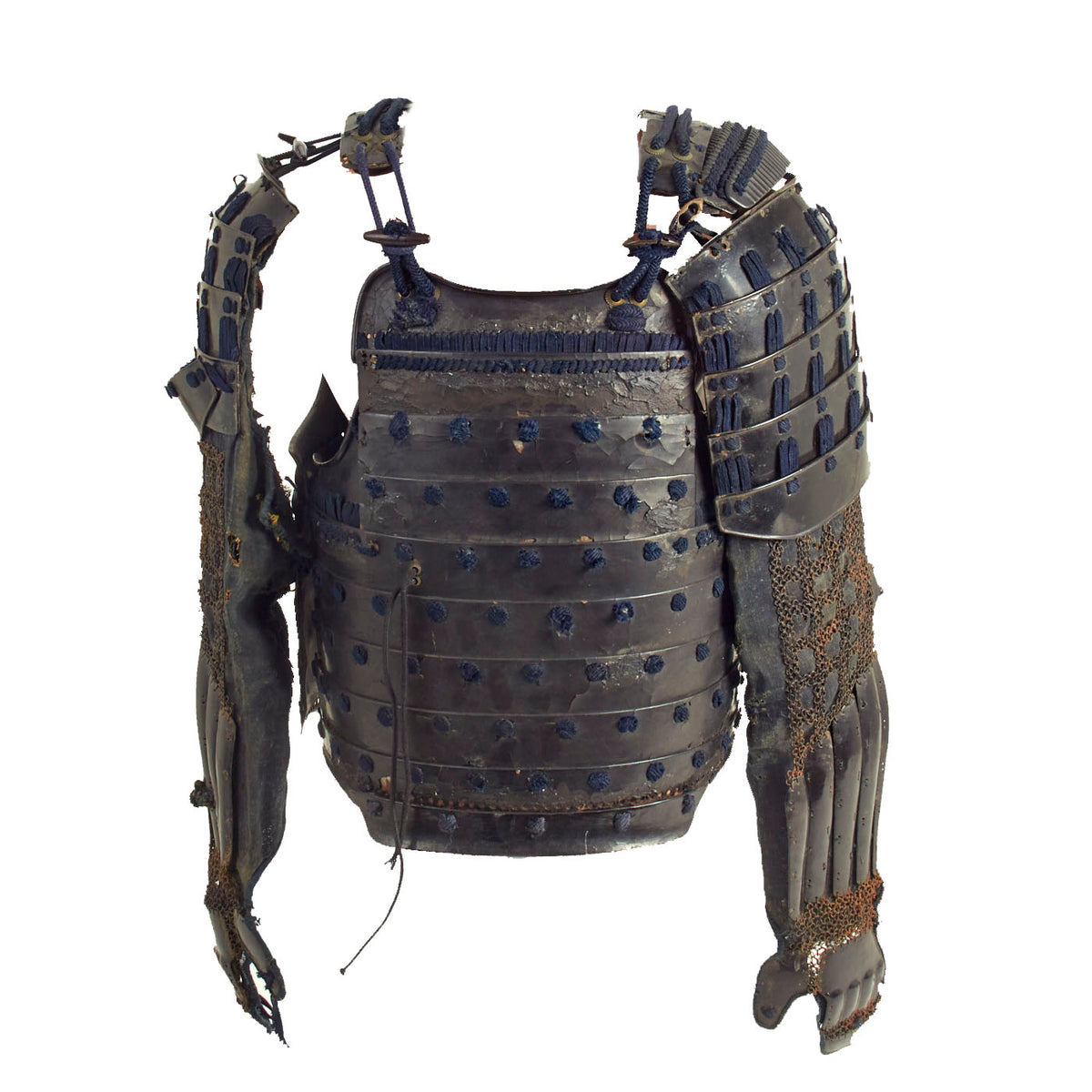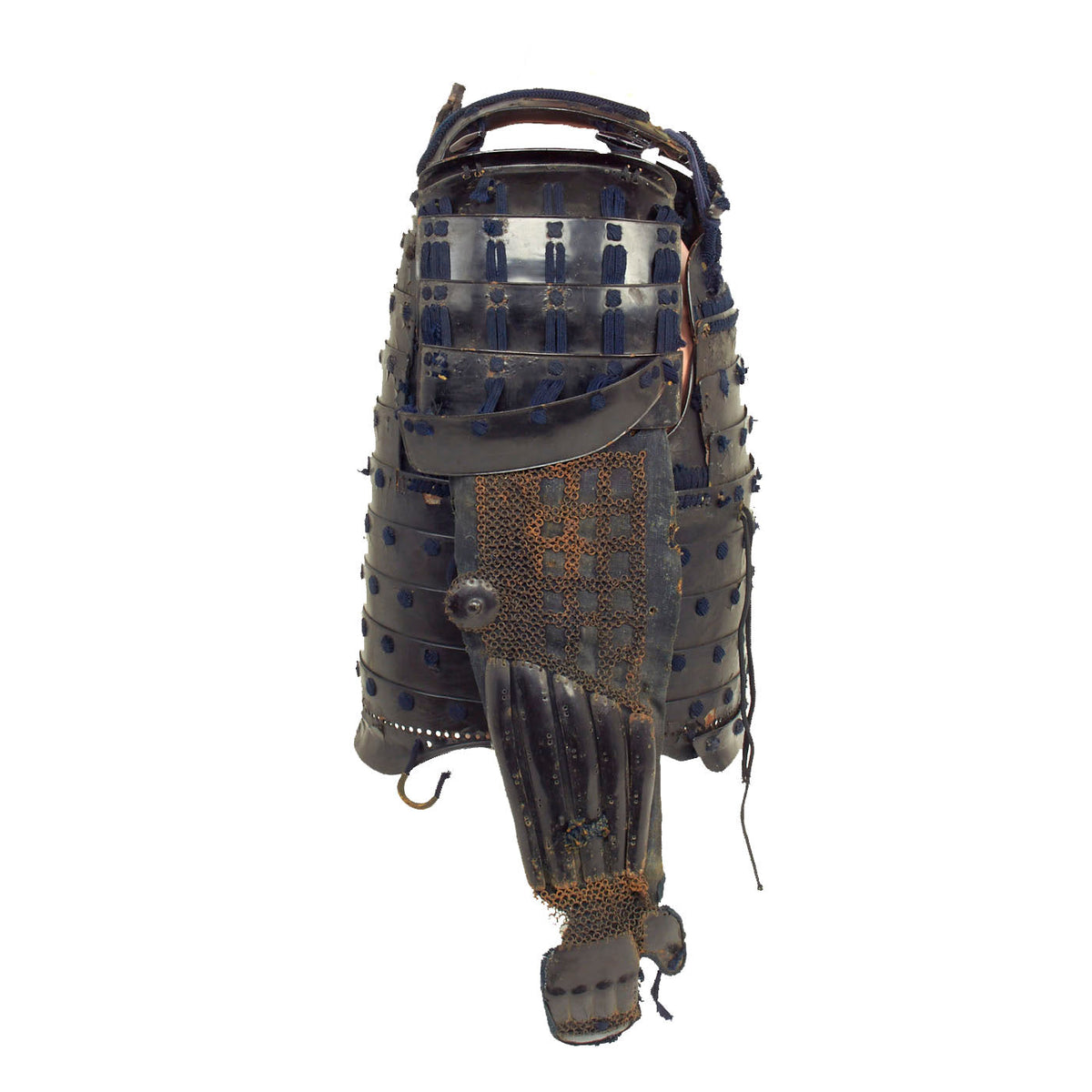Original 19th Century Japanese Samurai Edo Period Enameled Cuirass with Shoulder, Arm & Hand Armor Original Items
$ 1.395,00 $ 348,75
Original Item: One-of-a-kind set. Japanese armor is thought to have evolved from the armor used in ancient China and Korea. Cuirasses and helmets were manufactured in Japan as early as the 4th century. Tankō, worn by foot soldiers and keikō, worn by horsemen were both pre-samurai types of early Japanese cuirass constructed from iron plates connected together by leather thongs.
During the Heian period (794-1185), the Japanese cuirass evolved into the more familiar style of armor worn by the samurai known as the dou or dō. Japanese armor makers started to use leather (nerigawa) and lacquer was used to weatherproof the armor parts. By the end of the Heian period the Japanese cuirass had arrived at the shape recognized as being distinctly samurai. Leather and or iron scales were used to construct samurai armors, with leather and eventually silk lace used to connect the individual scales (kozane) which these cuirasses were now being made from.
In the 16th century Japan began trading with Europe during what would become known as the Nanban trade. Samurai acquired European armour including the cuirass and comb morion which they modified and combined with domestic armour as it provided better protection from the newly introduced matchlock muskets known as Tanegashima. The introduction of the tanegashima by the Portuguese in 1543 changed the nature of warfare in Japan causing the Japanese armor makers to change the design of their armours from the centuries-old lamellar armours to plate armour constructed from iron and steel plates which was called tosei gusoku (new armours). Bullet resistant armours were developed called tameshi gusoku or (bullet tested) allowing samurai to continue wearing their armour despite the use of firearms.
The era of warfare called the Sengoku period ended around 1600, Japan was united and entered the peaceful Edo period, samurai continued to use both plate and lamellar armor as a symbol of their status but traditional armours were no longer necessary for battles. During the Edo period light weight, portable and secret hidden armors became popular as there was still a need for personal protection. Civil strife, duels, assassinations, peasant revolts required the use of armours such as the kusari katabira (chain armor jacket) and armored sleeves as well as other types of armour which could be worn under ordinary clothing. Edo period samurai were in charge of internal security and would wear various types of kusari gusoku (chain armor) and shin and arm protection as well as forehead protectors (hachi-gane).
Armor continued to be worn and used in Japan until the end of the samurai era (Meiji period) in the 1860s, with the last use of samurai armor happening in 1877 during the Satsuma Rebellion.
Construction
Japanese armor was generally constructed from many small iron (tetsu) and/or leather (nerigawa) scales (kozane) and/or plates (ita-mono), connected to each other by rivets and macramé cords (odoshi) made from leather and/or braided silk, and/or chain armor (kusari). Noble families had silk cords made in specific patterns and colors of silk thread. Many of these cords were constructed of well over 100 strands of silk. Making these special silk cords could take many months of steady work, just to complete enough for one suit of armour. Japanese armour was designed to be as lightweight as possible as the samurai had many tasks including riding a horse and archery in addition to swordsmanship. The armour was usually brightly lacquered to protect against the harsh Japanese climate. Chain armour (kusari) was also used to construct individual armor pieces and full suits of kusari were even used.
This fine armor set we are offering dates from the first half of the 19th century, the later portion of the Edo period (江戸時代, Edo jidai) or Tokugawa period (徳川時代, Tokugawa jidai) of Japanese history. This is the period between 1603 and 1867, when Japan was under the rule of the Tokugawa shogunate and the country’s 300 regional daimyo. It is definitely a set made for use, and not a display piece. It is made from black enameled steel and iron plates, held together with fabric and leather, and has blue cording connecting most of the pieces. The sleeves feature chain mail protection between the various pieces of armor plate.
This armor set consists of the following components, all made from pieces of black lacquered enamel plate attached to fabric and leather:
– Dou (胴) Cuirass Chest Armor, which has an auxiliary shoulder protector on the left side
– 2X Sode (袖) Spaulders – Shoulder Armor
– 2X Kote (籠手) Vambraces – Forearm Armor
– 2X Tekkou (手甲) Gauntlet Gloves
These are all attached together, and the Dou opens on the right side. The interior of the chest plate is lined with black finished leather. The main means of securing the armor is via the blue fabric cords fastened with toggles made by horn. These are used both to secure the front of the breast plate, and to secure the arms to the breast plate as well. On the reverse of the breastplate is an iron hinged mount to which a pole could be secured to display a banner.
The armor shows obvious signs of honest wear and age, but regardless, displays handsomely. The Dou definitely looks to be older than the other components of the armor set, which is definitely common, as steel and iron were always scarce in Feudal Japan, so items would be reused for centuries. It shows many layers of enamel, and also some oxidation underneath, which has caused the paint to flake off. Please note that some of the blue cording that holds the armor together has deteriorated, so it should be handled with care.
This is genuine period armor, not reproduction, much more research can, and should, be conducted. This is a ready-to-display set of Edo period Samurai armor!
Fast Shipping with Professional Packaging
Thanks to our longstanding association with UPS FedEx DHL, and other major international carriers, we are able to provide a range of shipping options. Our warehouse staff is expertly trained and will wrap your products according to our exact and precise specifications. Prior to shipping, your goods will be thoroughly examined and securely secured. We ship to thousands clients each day across multiple countries. This shows how we're dedicated to be the largest retailer on the internet. Warehouses and distribution centres can be located throughout Europe as well as the USA.
Note: Orders with more than one item will be assigned a processing date depending on the item.
Before shipping before shipping, we'll conduct a thorough inspection of the items you have ordered. Today, the majority of orders will be delivered within 48 hours. The delivery time will be between 3-7 days.
Returns
The stock is dynamic and we cannot completely manage it because multiple stakeholders are involved, including our factory and warehouse. So the actual stock may alter at any time. It's possible that you may not receive your order once the order has been made.
Our policy is valid for a period of 30 days. If you don't receive the product within 30 days, we are not able to issue a refund or an exchange.
You can only return an item if it is unused and in the same state as the day you received it. You must have the item in its original packaging.
Related products
Uncategorized
Uncategorized
Uncategorized
Uncategorized
Armoured Fighting Vehicles of the World: AFVs of World War One (Hardcover Book) New Made Items
Uncategorized
Uncategorized
Uncategorized
Uncategorized
Uncategorized
Uncategorized
Uncategorized
Uncategorized
Uncategorized
Uncategorized
Australian WWII Owen MK1 Machine Carbine SMG Custom Fabricated Replica with Sling Original Items
Uncategorized
Uncategorized
Armored Burgonet Helmet & Polearm from Scottish Castle Leith Hall Circa 1700 Original Items
Uncategorized
Uncategorized
Angolan Rebel 1970s era 60mm Inert Display Mortar from Angolan Civil War Original Items
Uncategorized
Uncategorized












































































